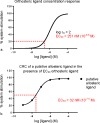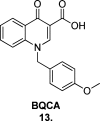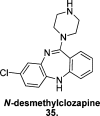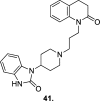Development of M1 mAChR allosteric and bitopic ligands: prospective therapeutics for the treatment of cognitive deficits
- PMID: 23659787
- PMCID: PMC3715844
- DOI: 10.1021/cn400086m
Development of M1 mAChR allosteric and bitopic ligands: prospective therapeutics for the treatment of cognitive deficits
Abstract
Since the cholinergic hypothesis of memory dysfunction was first reported, extensive research efforts have focused on elucidating the mechanisms by which this intricate system contributes to the regulation of processes such as learning, memory, and higher executive function. Several cholinergic therapeutic targets for the treatment of cognitive deficits, psychotic symptoms, and the underlying pathophysiology of neurodegenerative disorders, such as Alzheimer's disease and schizophrenia, have since emerged. Clinically approved drugs now exist for some of these targets; however, they all may be considered suboptimal therapeutics in that they produce undesirable off-target activity leading to side effects, fail to address the wide variety of symptoms and underlying pathophysiology that characterize these disorders, and/or afford little to no therapeutic effect in subsets of patient populations. A promising target for which there are presently no approved therapies is the M1 muscarinic acetylcholine receptor (M1 mAChR). Despite avid investigation, development of agents that selectively activate this receptor via the orthosteric site has been hampered by the high sequence homology of the binding site between the five muscarinic receptor subtypes and the wide distribution of this receptor family in both the central nervous system (CNS) and the periphery. Hence, a plethora of ligands targeting less structurally conserved allosteric sites of the M1 mAChR have been investigated. This Review aims to explain the rationale behind allosterically targeting the M1 mAChR, comprehensively summarize and critically evaluate the M1 mAChR allosteric ligand literature to date, highlight the challenges inherent in allosteric ligand investigation that are impeding their clinical advancement, and discuss potential methods for resolving these issues.
Figures





























Similar articles
-
M1 muscarinic acetylcholine receptors: A therapeutic strategy for symptomatic and disease-modifying effects in Alzheimer's disease?Adv Pharmacol. 2020;88:277-310. doi: 10.1016/bs.apha.2019.12.003. Epub 2020 Jan 27. Adv Pharmacol. 2020. PMID: 32416870 Review.
-
Bitopic Binding Mode of an M1 Muscarinic Acetylcholine Receptor Agonist Associated with Adverse Clinical Trial Outcomes.Mol Pharmacol. 2018 Jun;93(6):645-656. doi: 10.1124/mol.118.111872. Epub 2018 Apr 25. Mol Pharmacol. 2018. PMID: 29695609 Free PMC article.
-
Allosteric modulation of the M1 muscarinic acetylcholine receptor: improving cognition and a potential treatment for schizophrenia and Alzheimer's disease.Drug Discov Today. 2013 Dec;18(23-24):1185-99. doi: 10.1016/j.drudis.2013.09.005. Epub 2013 Sep 17. Drug Discov Today. 2013. PMID: 24051397 Free PMC article. Review.
-
Positive allosteric modulation of M1 and M4 muscarinic receptors as potential therapeutic treatments for schizophrenia.Neuropharmacology. 2018 Jul 1;136(Pt C):438-448. doi: 10.1016/j.neuropharm.2017.09.012. Epub 2017 Sep 9. Neuropharmacology. 2018. PMID: 28893562 Free PMC article. Review.
-
M1 muscarinic allosteric modulators slow prion neurodegeneration and restore memory loss.J Clin Invest. 2017 Feb 1;127(2):487-499. doi: 10.1172/JCI87526. Epub 2016 Dec 19. J Clin Invest. 2017. PMID: 27991860 Free PMC article.
Cited by
-
Molecular determinants of allosteric modulation at the M1 muscarinic acetylcholine receptor.J Biol Chem. 2014 Feb 28;289(9):6067-79. doi: 10.1074/jbc.M113.539080. Epub 2014 Jan 17. J Biol Chem. 2014. PMID: 24443568 Free PMC article.
-
Current Therapeutic Molecules and Targets in Neurodegenerative Diseases Based on in silico Drug Design.Curr Neuropharmacol. 2018;16(6):649-663. doi: 10.2174/1570159X16666180315142137. Curr Neuropharmacol. 2018. PMID: 29542412 Free PMC article. Review.
-
Activation of M1 and M4 muscarinic receptors as potential treatments for Alzheimer's disease and schizophrenia.Neuropsychiatr Dis Treat. 2014 Jan 28;10:183-91. doi: 10.2147/NDT.S55104. eCollection 2014. Neuropsychiatr Dis Treat. 2014. PMID: 24511233 Free PMC article. Review.
-
Muscarinic acetylcholine receptors: novel opportunities for drug development.Nat Rev Drug Discov. 2014 Jul;13(7):549-60. doi: 10.1038/nrd4295. Epub 2014 Jun 6. Nat Rev Drug Discov. 2014. PMID: 24903776 Free PMC article. Review.
-
Pyrrolopyridine or Pyrazolopyridine Derivatives.ACS Med Chem Lett. 2015 Jun 5;6(7):726-8. doi: 10.1021/acsmedchemlett.5b00185. eCollection 2015 Jul 9. ACS Med Chem Lett. 2015. PMID: 26191354 Free PMC article. No abstract available.
References
-
- van Koppen C. J.; Kaiser B. (2003) Regulation of muscarinic acetylcholine receptor signaling. Pharmacol. Ther. 98, 197–220. - PubMed
-
- Canals M.; Sexton P. M.; Christopoulos A. (2011) Allostery in GPCRs: “MWC” revisited. Trends Biochem. Sci. 36, 663–672. - PubMed
-
- Caulfield M. P. (1993) Muscarinic Receptors-Characterization, Coupling and Function. Pharmacol. Ther. 58, 319–379. - PubMed
-
- Fisher A. (2008) M1 Muscarinic Agonists Target Major Hallmarks of Alzheimer’s Disease - The Pivotal Role of Brain M1 Receptors. Neurodegener. Dis. 5, 237–240. - PubMed
Publication types
MeSH terms
Substances
LinkOut - more resources
Full Text Sources
Other Literature Sources
Medical

